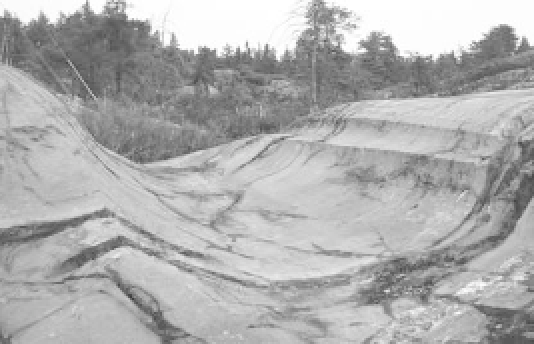Geology Reference
In-Depth Information
off sharply where it meets the steep wall of the main valley
(Colour Plate 13), often with a waterfall coursing over
the edge.
of meltwater under pressure. Bedrock bearing a multi-
tude of tiny scratches has a polished look. The finer is
the abrading material, the higher is the polish. Stria-
tions are equivocal evidence of ice action, especially in the
geological record, as such other processes as avalanches
and debris flows are capable of scratching bedrock.
Rock
basins
are depressions with diameters in the range sev-
eral metres to hundreds of metres, carved into bedrock,
commonly found in association with roches moutonnées.
They form where rocks contain structural weaknesses
exploitable by glacial erosion.
Domes and whalebacks
A variety of glacially abraded forms are less than about
100 m in size.
Domes
and
whalebacks
(
rock drumlins
,
tadpole rocks
,
streamlined hills
) form where flowing
ice encounters an obstruction and, unable to obliterate
it, leaves an upstanding, rounded hillock.
Plastically moulded forms
Striated, polished, and grooved bedrock
Some glaciated rock surfaces carry complex, smooth
forms known as
plastically moulded forms
,or
p-forms
(Plates 10.6 and 10.7). The origin of these puzzling fea-
tures is debatable. Possibilities are glacial abrasion, the
motion of saturated till (till slurry) at the bottom or sides
of a glacier, and meltwater erosion, especially meltwater
under high pressure beneath a glacier. If a meltwater
origin is certain, then the features are
s-forms
.
Striated, polished, and grooved surfaces are all fashioned
by rock material carried by flowing ice. Large clasts (about
1 cm or bigger) erode by scratching and create striations
and grooves. Finer material (less than a centimetre or
so), and especially the silt fractions, erodes by polish-
ing bedrock surfaces.
Striations
are finely cut, U-shaped
grooves or scratches, up to a metre long or more, scored
into bedrock by the base of a sliding glacier. They come
in a multiplicity of forms, some of which, such as rat-
tails, indicate the direction of ice flow. Large striations are
called
grooves
, which attain depths and widths of a few
metres and lengths of a few hundred metres (Plate 10.5).
Glacial valleys may be thought of as enormous grooves.
Grooves form through glacial abrasion or the generation
Abrasion-cum-rock-fracture landforms
In combination, glacial abrasion and rock fracture pro-
duce partly streamlined landforms that range in size from
about1mto10km(Table 10.2).
Trough heads, valley steps, and riegels
Trough heads
(or
trough ends
) and
valley steps
are sim-
ilar to roche moutonnées (see below) but larger. Trough
heads are steep and rocky faces that mark the limit of over-
deepening of glacial troughs. Their 'plucked' appearance
suggests that they may follow original breaks of slope
related to hard rock outcrops. In sliding over the break
of slope, the ice loses contact with the ground, creating a
cavity in which freeze-thaw processes aid the loosening of
blocks. The ice reconnects with the ground further down
the valley. Where another hard rock outcrop associated
with an original break of slope is met, a rock or valley step
develops by a similar process. However, the formation of
trough heads and rock steps is little researched and far
from clear.
Plate 10.5
Two-metre deep striated groove carved by the
Laurentide ice sheet, Whitefish Falls, Ontario, Canada.
(
Photograph by Mike Hambrey
)

